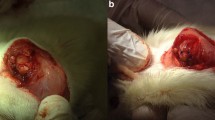Abstract
Introduction
The rotator cuff has a characteristic structure, in that one surface faces articular cartilage and another faces bursa. This structure may produce differences in the healing process between the rotator cuff and other tendons. We investigated the spontaneous healing process of a surgically created supraspinatus tendon tear in rabbits.
Materials and methods
A transverse, full-thickness tear of the supraspinatus tendon was created and its healing examined.
Results
A tear of 12 mm was not repaired within 3 weeks. With a tear of 5 mm, reparative tissue gradually encroached into the defect from the bursal side, and the tear united from the bursal side to the articular side by 12 weeks. The healing rates (width of reparative tissue/width of the tendon×100%) were 32.2%, 52.4%, 58.0%, 88.9%, and 93.8% at 1, 2, 3, 6, and 12 weeks, respectively. The reparative tissue had continuity to the epitenon of the bursal side. Immunohistochemical study showed that at week 1, type III collagen was detected in the reparative tissue and the cutting ends, and the expression gradually decreased. On the other hand, the expression of type I collagen in the reparative tissue was weak at week 1 and increased until week 3. PCNA-positive cells were observed in the reparative tissue.
Conclusion
These results show that the origin of the reparative tissue is the epitenon, and from the bursal side rather than the articular side. This model is very useful for the investigation of the remodeling process of an acute rotator cuff tear.






Similar content being viewed by others
References
Abrahamsson SO, Lundborg G, Lohmander LS (1992) Restoration of the injured flexor tendon surface: a possible role for endotenon cells. A morphological study of the rabbit tendon in vivo. J Hand Surg Br 17:553–560
Birk DE, Mayne R (1997) Localization of collagen types I, III and V during tendon development. Changes in collagen types I and III are correlated with changes in fibril diameter. Eur J Cell Biol 72:352–361
Björkenheim JM, Paavolainen P, Ahovuo J, Slatis P (1990) Resistance of a defect of the supraspinatus tendon to intraarticular hydrodynamic pressure: an experimental study on rabbits. J Orthop Res 8:175–179
Carpenter JE, Thomopoulos S, Flanagan CL, DeBano CM, Soslowsky LJ (1998) Rotator cuff defect healing: a biomechanical and histologic analysis in an animal model. J Shoulder Elbow Surg 7:599–605
Choi HR, Kondo S, Hirose K, Ishiguro N, Hasegawa Y, Iwata H (2002) Expression and enzymatic activity of MMP-2 during healing process of the acute supraspinatus tendon tear in rabbits. J Orthop Res 20:927–933
Fan L, Sarkar K, Franks DJ, Uhthoff HK (1997) Estimation of total collagen and types I and III collagen in canine rotator cuff tendons. Calcif Tissue Int 61:223–229
Gartsman GM (2001) All arthroscopic rotator cuff repairs. Orthop Clin North Am 32:501–510
Gelberman RH, Amiel D, Harwood F (1992) Genetic expression for type I procollagen in the early stages of flexor tendon healing. J Hand Surg Am 17:551–558
Kumagai J, Sarkar K ,Uhthoff HK (1993) Repair process of surgically produced rotator cuff tear (abstract). Trans Orthop Res Soc 18:315
Kumagai J, Sarkar K, Uhthoff HK, Okawara Y, Ooshima A (1994) Immunohistochemical distribution of type I, II and III collagens in the rabbit supraspinatus tendon insertion. J Anat 185:279–284
Sano H, Kumagai J, Sawai T (2002) Experimental fascial autografting for the supraspinatus tendon defect: remodeling process of the grafted fascia and the insertion into bone. J Shoulder Elbow Surg 11:166–173
Soslowsky LJ, Carpenter JE, DeBano CM, Banerji I, Moalli MR (1996) Development and use of an animal model for investigations on rotator cuff disease. J Shoulder Elbow Surg 5:383–392
Uhthoff HK, Sarkar K (1991) Surgical repair of rotator cuff ruptures. The importance of the subacromial bursa. J Bone Joint Surg Br 73:399–401
Von der Mark K (1981) Localization of collagen types in tissues.Int Rev Connect Tissue Res 9:265–324
Williams IF, McCullagh KG, Silver IA (1984) The distribution of types I and III collagen and fibronectin in the healing equine tendon. Connect Tissue Res 12:211–227
Author information
Authors and Affiliations
Corresponding author
Rights and permissions
About this article
Cite this article
Hirose, K., Kondo, S., Choi, HR. et al. Spontaneous healing process of a supraspinatus tendon tear in rabbits. Arch Orthop Trauma Surg 124, 374–377 (2004). https://doi.org/10.1007/s00402-004-0663-8
Received:
Published:
Issue Date:
DOI: https://doi.org/10.1007/s00402-004-0663-8




